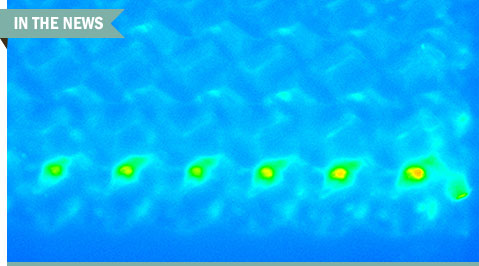 Image credit: National Institute of Standards and Technology
Image credit: National Institute of Standards and Technology
Point-of-care (POC) diagnostics are all the rage, with new devices launched practically every day to track and monitor health and disease in ways that once could only be imagined. In an afternoon symposium at AACC's Annual Meeting & Clinical Lab Expo on July 30, “Next-Generation Point-of-Care Diagnostics—Technologies, Design and Prototyping” (35202), three entrepreneur speakers from academia and industry—each focused on different aspects of next-generation POC technologies—will give attendees a peek at the amazing, rapidly evolving world of POC diagnostics.
Aydogan Ozcan, PhD, chancellor’s professor of electrical engineering at University of California, Los Angeles, and a Howard Hughes Medical Institute professor, will look at the democratization of next-generation imaging, diagnostics, and measurement tools through computational photonics.
Joining Ozcan will be B. Scott Ferguson, PhD, CEO and founder of Aptitude Medical Systems, a developer of synthetic affinity molecules. He will be speaking on real-time, aptamer-based tracking of circulating therapeutic agents in live animals. The symposium’s final speaker will be Aaron Rowe, Ph.D., a research scientist at Fitbit, which produces fitness apps that track activity, exercise, food, weight, and sleep. He will discuss new tools for cost-effectively prototyping point-of-care diagnostic instruments and consumables.
For his part, Ozcan told CLN Stat he expects to discuss “computational optical imaging and sensing technologies that aim medical diagnostics and testing in resource-limited settings, POC offices, remote locations, and even at the home.” He added that “some of these platforms will be integrated with smartphones to convert the phone into a high-end microscope, blood analyzer, pathogen detector, heavy metal detector, allergen sensor, etc.”
If these applications seem far removed from everyday use, Ozcan cautioned otherwise. “Some of these technologies that I will present are already commercialized as a spinoff from my lab at UCLA and are already being used in the research market, and the Food and Drug Administration approval process is under progress.”
He emphasized that POC diagnostics face a bright and shiny future. “The field is rapidly evolving, and we will see advanced biomedical measurements, testing, and screening to diffuse into the most resource-scarce settings, enabling various new avenues to foster telemedicine and mobile health applications. These efforts will not only impact developing countries but also the developed ones, by converting our homes into [around-the-clock] laboratories which will be crucial to monitor and treat chronic patients as well as aging populations.”
Register online to attend this forward-looking symposium for a glimpse of POC possibilities, both now and in the future.